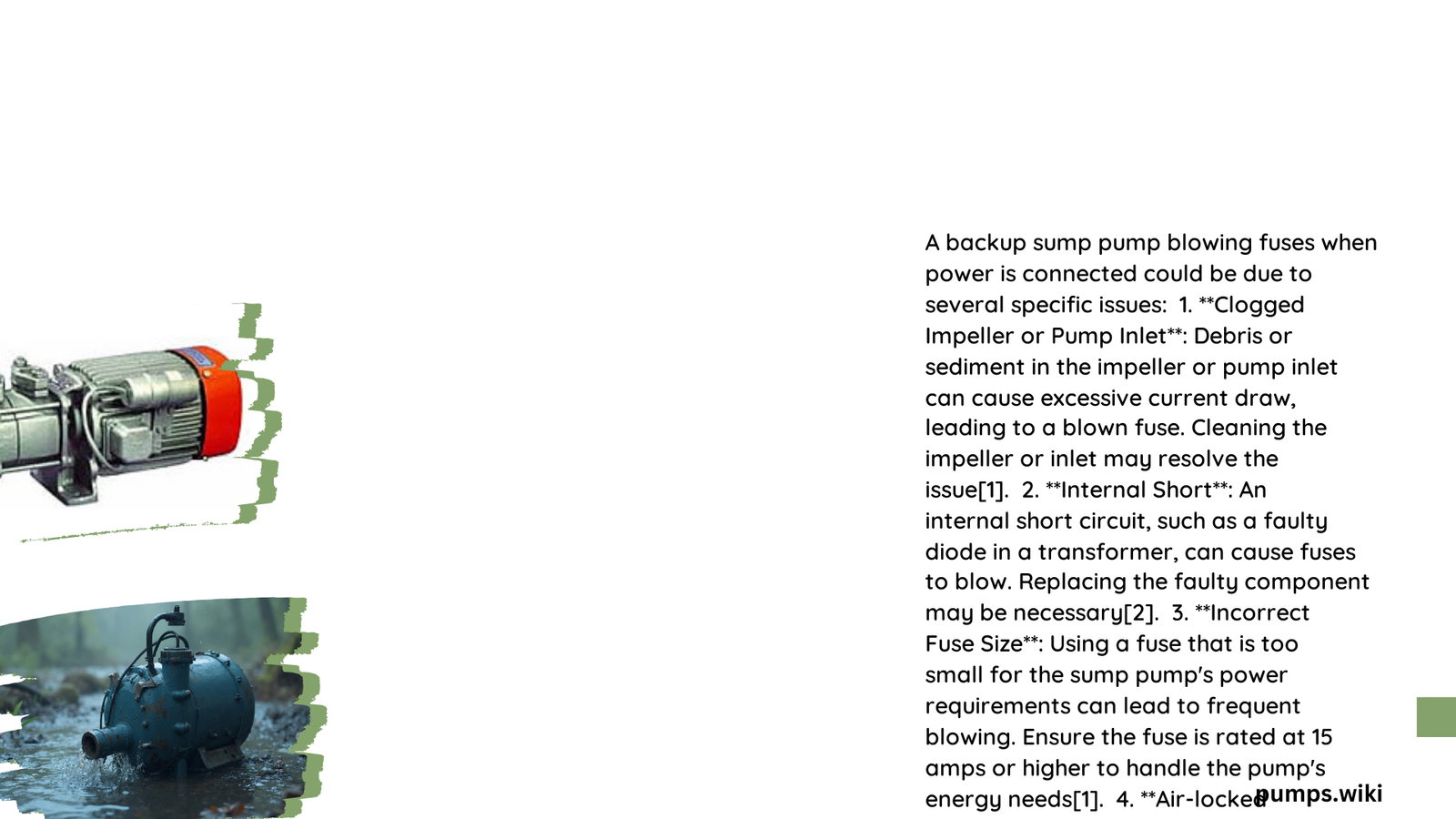A backup sump pump blowing fuses when power is connected can be a frustrating and potentially dangerous issue. This problem often stems from electrical mismatches, faulty wiring, or pump malfunctions. Understanding the root causes and implementing proper troubleshooting techniques is crucial for maintaining a functional backup sump pump system and preventing water damage in your home.
Why Does My Backup Sump Pump Blow Fuses When Connected to Power?
The primary reasons for a backup sump pump blowing fuses upon power connection include:
- Incorrect fuse or circuit breaker size
- Clogged impeller or pump inlet
- Faulty electrical connections
- Voltage mismatches
- Damaged pump motor
Let’s delve deeper into each of these causes and explore potential solutions.
What Are the Common Electrical Specifications for Backup Sump Pumps?

Understanding the electrical requirements of your backup sump pump is crucial for proper operation:
- AC-powered backup pumps: Typically require 13.8–15 VAC output from the power adapter
- DC-powered backup pumps: Usually need 12.4 VDC or greater output from the control box
- Circuit capacity: Most sump pumps require a 15-amp or higher electrical circuit
| Pump Type | Voltage Requirement |
|---|---|
| AC-powered | 13.8–15 VAC |
| DC-powered | 12.4 VDC or greater |
Ensuring your electrical setup meets these specifications can help prevent fuse-blowing issues.
How Can I Troubleshoot a Backup Sump Pump That Blows Fuses?
Follow these steps to diagnose and potentially resolve the issue:
- Use a voltmeter:
- For AC pumps: Set to AC volts and check for 13.8–15 VAC
-
For DC pumps: Set to DC volts and check for 12.4 VDC or greater
-
Check power connections:
- Ensure the power adapter is securely plugged into both the outlet and the controller
-
Test the outlet and GFI (if present)
-
Inspect and replace fuses:
- Disconnect the control box from the battery and unplug the pump
- Replace the DC fuse with a new one of the same amp rating
-
Reconnect and test
-
Perform continuity checks:
- Use a voltmeter to check the DC output of the control box to the pump
- Insert leads into the pump Molex holes on the control box
- Lift the float switch and verify 12.4 VDC or greater reading
What Types of Fuses Are Used in Backup Sump Pumps?
Choosing the correct fuse is critical for proper pump operation:
- DC fuses: Match the amp rating to the pump’s requirements (e.g., 15A DC fuse for a 15-amp pump)
- AC fuses: Should align with the pump’s electrical specifications
Using incorrect fuse types can lead to:
– Frequent fuse blowing
– Reduced pump performance
– Potential damage to the pump and control box
Always consult your pump’s manual for specific fuse requirements.
What Specific Electrical Problems Can Cause Fuse Failure in Backup Sump Pumps?
Several electrical issues can contribute to fuse failure:
- Exposed or damaged wires:
- Can cause short circuits
-
May lead to frequent fuse blowing
-
Overload conditions:
- Often caused by clogged impellers or pump inlets
-
Result in excessive power draw, blowing fuses or tripping circuit breakers
-
Incorrect circuit breaker sizing:
- Undersized breakers may trip frequently
- Oversized breakers may not provide adequate protection
To address these issues:
– Regularly inspect wiring for damage
– Clean pump components to prevent clogs
– Ensure circuit breakers are correctly sized for your pump
How Can I Prevent My Backup Sump Pump from Blowing Fuses in the Future?
Implement these preventive measures to reduce the likelihood of fuse-blowing incidents:
- Regular maintenance:
- Clean the pump and its components monthly
-
Check for and remove any debris that could cause clogs
-
Proper installation:
- Ensure the pump is connected to a dedicated circuit
-
Use a GFCI outlet not controlled by a wall switch
-
Correct fuse selection:
- Always use fuses that match your pump’s specifications
-
Keep spare fuses on hand for quick replacements
-
Professional inspection:
- Have an electrician check your pump’s wiring annually
- Address any potential issues before they cause problems
By following these guidelines, you can significantly reduce the risk of your backup sump pump blowing fuses when connected to power.
What Should I Do If My Backup Sump Pump Continues to Blow Fuses After Troubleshooting?
If you’ve followed the troubleshooting steps and your backup sump pump still blows fuses:
- Consult a professional:
- Contact a licensed electrician or pump specialist
-
They can perform advanced diagnostics and repairs
-
Consider replacement:
- If the pump is old or frequently malfunctioning, it may be time for a new unit
-
Choose a pump that matches your home’s requirements and electrical specifications
-
Review warranty options:
- Check if your pump is still under warranty
- The manufacturer may offer repair or replacement services
Remember, a properly functioning backup sump pump is crucial for protecting your home from water damage. Don’t hesitate to seek professional help if you’re unable to resolve the issue on your own.
